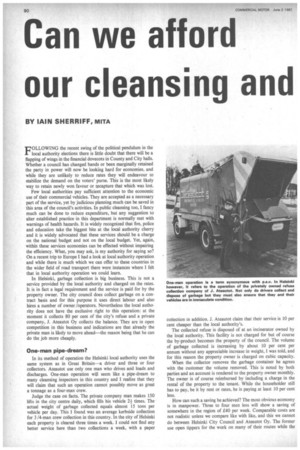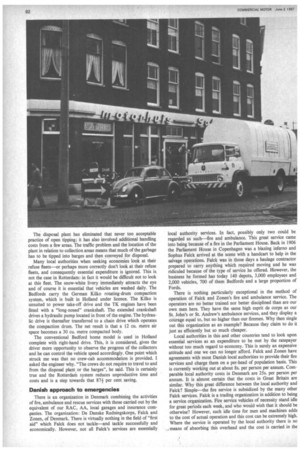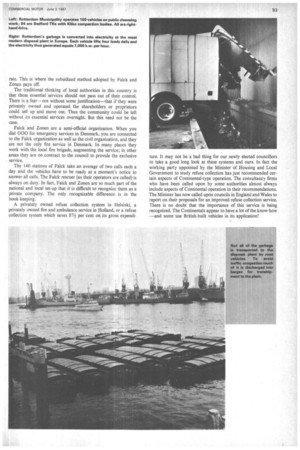Can we afford our cleansing and fire services?
Page 92

Page 93

Page 94

Page 95

If you've noticed an error in this article please click here to report it so we can fix it.
BY IAIN SHERRIFF, MITA vOLLOWING the recent swing of the political pendulum in the
local authority elections there is little doubt that there will be a flapping of wings in the financial dovecots in County and City halls. Whether a council has changed hands or been marginally retained the party in power will now be looking hard for economies, and while they are unlikely to reduce rates they will endeavour to stabilize the demand on the voters' purse. This is the most likely way to retain newly won favour or tecapture that which was lost.
Few local authorities pay sufficient attention to the economic use of their commercial vehicles. They are accepted as a necessary part of the service, yet by judicious planning much can be saved in this area of the council's activities. In public cleansing too, I fancy much can be done to reduce expenditure, but any suggestion to alter established practice in this department is normally met with warnings of health hazards. It is widely recognized that fire, police and education take the biggest bite at the local authority cherry and it is widely advocated that these services should be a charge on the national budget and not on the local budget. Yet, again, within these services economies can be effected without impairing the efficiency. What, you may ask, is my authority for saying so? On a recent trip to Europe I had a look at local authority operation and while there is much which we can offer to these countries in the wider field of road transport there were instances where I felt that in local authority operation we could learn.
In Helsinki, garbage collection is big business. This is not a service provided by the local authority and charged on the rates. It is in fact a legal requirement and the service is paid for by the property owner. The city council does collect garbage on a contract basis and for this purpose it uses direct labour and also hires a number of owner /operators. Nevertheless the local authority does not have the exclusive right to this operation: at the moment it collects 80 per cent of the city's refuse and a private company, J. Ateautot Oy collects the balance. They are in open competition in this business and indications are that already the private man is likely to move ahead—the reason being that he can do the job more cheaply.
One-man pipe-dream?
In its method of operation the Helsinki local authority uses the same system as in Great Britain—a driver and three or four collectors. Ateautot use only one man who drives and loads and discharges. One-man operation will seem like a pipe-dream to many cleansing inspectors in this country and I realize that they will claim that such an operation cannot possibly move as great a tonnage as a four-man crew.
Judge the case on facts. The private company man makes 150 lifts in the city centre daily, which fills his vehicle 2+ times. The actual weight of garbage collected equals almost 15 tons per vehicle per clay. This I found was an average kerbside collection for 3 /4-man crew collection in this country. In the city of Helsinki each property is cleared three times a week. I could not find any better service here than two collections a week, with a paper collection in addition. J. Ateautot claim that their service is 10 per cent cheaper than the local authority's.
The collected refuse is disposed of at an incinerator owned by the local authority. This facility is not charged for but of course the by-product becomes the property of the council. The volume of garbage collected is increasing by about 10 per cent per annum without any appreciable increase in weight, I was told, and for this reason the property owner is charged on cubic capacity.
When the collector removes the garbage container he agrees with the customer the volume removed. This is noted by both parties and an account is rendered to the property owner monthly. The owner is of course reimbursed by including a charge in the rental of the property to the tenant. While the householder still has to pay, be it by rent or rates, he is paying at least 10 per cent less.
How can such a saving be achieved? The most obvious economy is in manpower. Three to four men less will show a saving of somewhere in the region of £40 per week. Comparable costs are not realistic unless we compare like with like, and this we cannot do between Helsinki City Council and Ateautot Oy. The former use open tippers for the work on many of their routes while the private company uses modern, dustless, constant-compaction vehicles.
This private refuse collection fleet is standardized on Bedford chassis and fitted with a glassfibre plastics body using the Swedishbuilt Norba worm compaction equipment. The bodies have 12 cubic metre air space and 50 Cu. m. compacted capacity. The company maintains its 12 vehicles with two mechanics and in accordance with Bedford's specification. The compaction equipment with the attendant "plumbing" and its exposure to the hazards created by abrasives requires almost as much attention as the vehicle. In this connection, the company's mechanics have attended courses at the Norba plant in Sweden.
How many local authorities can claim a waiting list for a refuse collector's job? Ateautot can: they pay a high basic wage and a bonus on volume lifted, they don't need to look for men and they engage only top-class operators. A refuse collector in this organization is recognized as one of the elite in the driving fraternity.
One small pint in the operation which plays a large part in its success is timing. The vehicles are out at 5 a.m. daily in the town centre, clearing away before the city awakes and before the traffic begins to roll. Thus traffic jams are avoided and delay in collection does not exist. Ateautot get greater productivity per than than any local authority I know. Three to four times as much.
Refuse at 874per cent off
Nearer to the British method of operation is that adopted by Rotterdam Municipality. The 730,000 population of Rotterdam produces 250,000 tons of garbage annually—and they sell it.
Rotterdam city claims to have the most modern garbage disposal plant in Europe. In January 1965 the plant was opened not primarily as a garbage disposal plant but as an electricity generating station. The station today produces 7,000 kw per hour and while it does not cater for all of the city's power needs it goes some way to reducing the cost of collection and disposal of garbage. In addition the waste ash produced from the garbage is re-sold as fertilizer.
These two processes reduce the cost of garbage collection considerably. The gross cost of garbage collection to the authority is £.1+m. per annum or £6 per family; the cost after deduction of income is 15s. per family per annum—a saving of almost 87+ per cent. What is more important, the cost of garbage collection is not lost in the general rate—it is seen, and each family is charged for the service separately.
You may feel that such a low charge results from other special features in the system. There are special features but they are more likely to add to the cost rather than reduce it. Because of its canal system, Rotterdam has very special traffic problems. Bottling up at bridges is commonplace and slow-moving refuse collection vehicles would add to the hazard. This has been taken into account and the city has built five garages strategically placed to house its 100 Bedfords. The disposal plant has eliminated that never too acceptable practice of open tipping; it has also involved additional handling costs from a few areas. The traffic problem and the location of the plant in relation to collection areas means that much of the garbage has to be tipped into barges and then conveyed for disposal.
Many local authorities when seeking economies look at their refuse fleets—or perhaps more correctly don't look at their refuse fleets, and consequently essential expenditure is ignored. This is. not the case in Rotterdam: in fact it would be difficult not to look at this fleet. The snow-white livery immediately attracts the eye and of course it is essential that vehicles are washed daily. The Bedfords carry the German Kilko rotating-drum compaction system, which is built in Holland under licence. The Kilko is unsuited to power take-off drive and the TK engines have been fitted with a "long-nosed" crankshaft. The extended crankshaft drives a hydraulic pump located in front of the engine. The hydraulic drive is thereafter transferred to a chain drive which operates the compaction drum. The net result is that a 12 cu. metre air space becomes a 30 cu. metre compacted body.
The conventional Bedford home model is used in Holland complete with right-hand drive. This, it is considered, gives the driver more opportunity to observe the progress of the collectors and he can control the vehicle speed accordingly. One point which struck me was that no crew-cab accommodation is provided. I asked the engineer why. "The crews do not require to travel to and from the disposal plant or the barges", he said. This is certainly true and the Rotterdarn system reduces unproductive time and costs and is a step towards that 87+ per cent saving.
Danish approach to emergencies There is an organization in Denmark combining the activities of fire, ambulance and rescue services with those carried out by the equivalent of our RAC, AA, local garages and insurance corn.panies. The organization: De Danske Redningskorps, Falck and Zonen, of Denmark. There is virtually nothing in the field of "first aid" which Falck does not tackle—and tackle successfully and economically. However, not all Falck's services are essentially local authority services. In fact, possibly only two could be regarded as such—fire and ambulance. This great service came into being because of a fire in the Parliament House. Back in 1906 the Parliament House in Copenhagen was a blazing inferno and Sophus Falck arrived at the scene with a handcart to help in the salvage operations. Falck was in those days a haulage contractor prepared to carry anything which required moving and he was ridiculed because of the type of service he offered. However, the business he formed has today 140 depots, 3,000 employees and 2,000 vehicles, 700 of them Bedfords and a large proportion of Fords.
There is nothing particularly exceptional in the method of operation of Falck and Zonen's fire and ambulance service. The operators are no better trained nor better disciplined than are our own men here. They have the same high esprit de corps as our St. John's or St. Andrew's ambulance services, and they display a courage equal to, but no higher than our firemen. Why then single out this organization as an example? Because they claim to do it just as efficiently but so much cheaper.
Local authorities in this and other countries tend to look upon essential services as an expenditure to be met by the ratepayer without too much regard to economy. This is surely an expensive attitude and one we can no longer afford. Falck and Zonen have agreements with most Danish local authorities to provide their fire services and charge them on a per-head of population basis. This is currently working out at about 8s. per person per annum. Comparable local authority costs in Denmark are 25s. per person per annum. It is almost certain that the costs in Great Britain are similar. Why this great difference between the local authority and Falck? Simple—the fire service is subsidized by the many other Falck services. Falck is a trading organization in addition to being a service organization. Fire service vehicles of necessity stand idle for great periods each week, and who would wish that it should be otherwise? However, such idle time for men and machines adds to the cost of actual operation and this cost can be extremely high. Where the service is operated by the local authority there is nc means of absorbing this overhead and the cost is carried in the rate. This is where the subsidized method adopted by Falck and Zonen pays off.
The traditional thinking of local authorities in this country is that these essential services should not pass out of their control. There is a fear—not without some justification—that if they were privately owned and operated the shareholders or proprietors could sell up and move out. Thus the community could be left without its essential services overnight. But this need not be the case. • Falck and Zonen are a semi-official organization. When you dial 000 for emergency services in Denmark, you are connected to the Falck organization as well as the civil organization, and they are not the only fire service in Denmark. In many places they work with the local fire brigade, augmenting the service; in other areas they are on contract to the council to provide the exclusive service.
The 140 stations of Falck take an average of two calls each a day and the vehicles have to be ready at a moment's notice to answer all calls. The Falck rescuer (as their operators are called) is always on duty. In fact, Falck and Zonen are so much part of the national and local set-up that it is difficult to recognize them as a private company. The only recognizable difference is in the book-keeping.
A privately owned refuse collection system in Helsinki, a privately owned fire and ambulance service in Holland, or a refuse collection system which saves 87+ per cent on its gross expendi ture. It may not be a bad thing for our newly elected councillors to take a good long look at these systems and ours. In fact the working party appointed by the Minister of Housing and Local Government to study refuse collection has just recommended certain aspects of Continental-type operation. The consultancy firms who have been called upon by some authorities almost always include aspects of Continental operation in their recommendations. The Minister has now called upon councils in England and Wales to report on their proposals for an improved refuse collection service. There is no doubt that the importance of this service is being recognized. The Continentals appear to have a lot of the know-how —and some use British-built vehicles in its application!




























































































































































